Review and images by JimoAi; edited by bmathison1972
Animals with misleading names are baffling and humorous at the same time. There is the great white shark, which is about 80% gray, the bearcat, which is neither a bear nor a cat, A red panda isn’t a panda, a horny toad isn’t a toad, the list goes on. Today we will be taking a look at one such example: the sand tiger shark (Carcharias taurus). Its other common names are the grey nurse shark and the ragged-toothed shark. Despite this, it has almost nothing in common with the tiger and nurse sharks, other than being a shark and is more closely related to sharks like the great white, mako, goblin and megamouths. The sand tiger is found in the Atlantic, Indian, Pacific, and Adriatic seas, inhabiting tropical or rocky reefs, bays, coastal waters and estuaries in the epipelagic and mesopelagic zones. Females are larger than males and these sharks are uterine cannibals: a female sand tiger has 2 uteruses, both producing about 50 embryos each. In each embryo, there will be 1 embryo that would develop into a baby shark the fastest and once it’s absorbed the nourishment from it’s yolk sack, will begin eating the other embryos, until there is only one pup per uterus. This however, is advantageous as it allows the pups to be more efficient hunters once they exit the mother’s uterus as they already have developed teeth. These sharks are have a fearsome appearance with their tiny pupils and needle like teeth, but despite that, these sharks are docile and only attack when provoked. These sharks are nocturnal and their needle-like teeth are used to grip onto slippery fish, squid, crustaceans and smaller sharks and rays. Due to their fearsome appearance yet relatively docile nature and their adaptability, these sharks are the most popular large sharks in public aquaria and may be the only lamniform shark in captivity (RIP the 330 cm male great white that died at the Okinawa Aquarium in 2016). Part of this is due to these sharks ability to gulp air from the surface, which is stored in the sharks’ stomach and it allows them to drift motionless to stalk on prey. These sharks only have about 2 pups every second or third year and because of that, these sharks population is decreasing due to overfishing for food in some areas and pollution and due to their low reproductive rate, cannot replenish themselves fast enough and are thus listed as Vulnerable by the IUCN and are a protected species in much of its range.
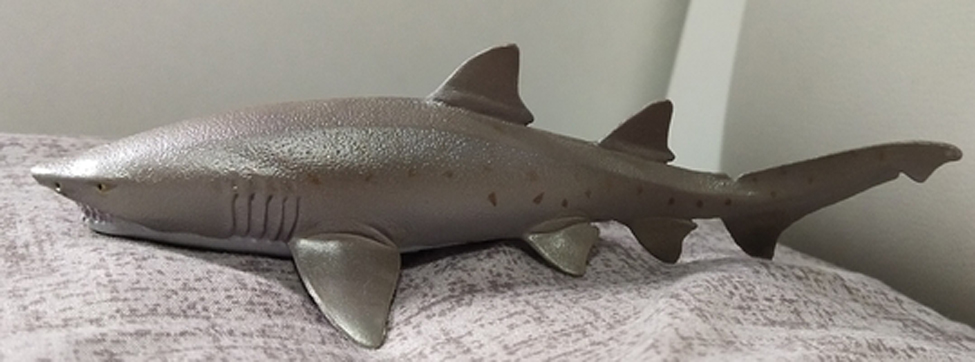
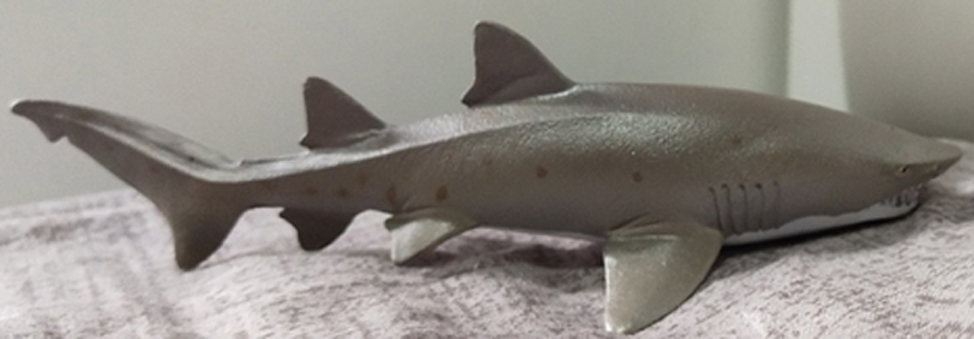
Damn animal names!
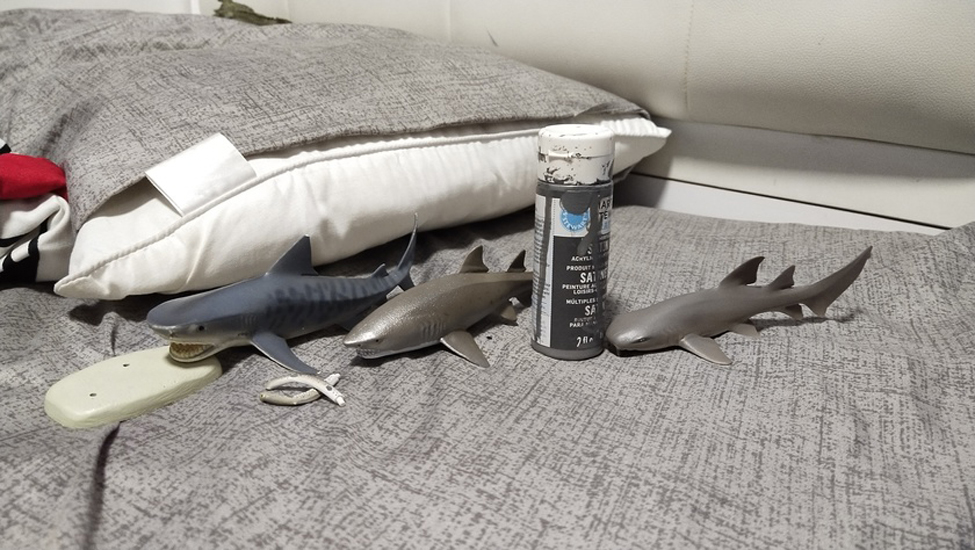
About the figure: this shark measures at 16.5 cm from the tip of the nose to the tip of the top caudal fin. Female sand tiger sharks get between 220 cm to 300 cm as adults, but the largest one is about 330 cm, which puts this figure in the 1:13.33-1:20 in scale. This figure, like most sharks, are sculpted as a female in contrast to most toothed whales like orcas and narwhals that are mostly sculpted as males.
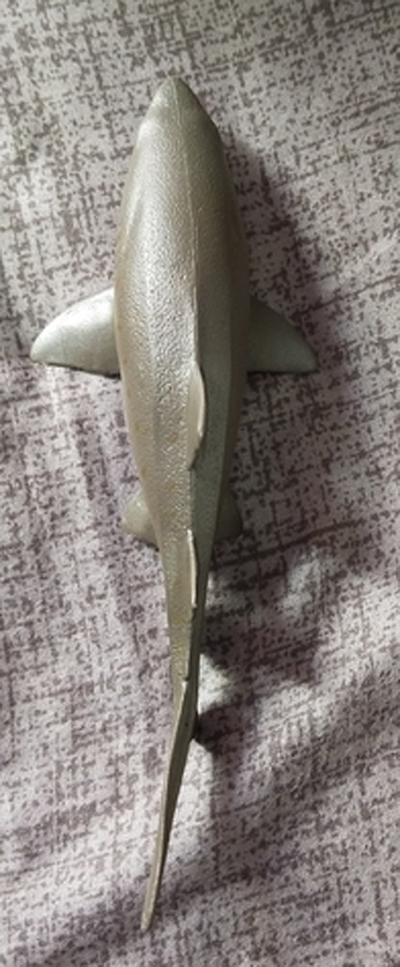
The figure is sculpted in a static neutral pose, probably to show the shark drifting motionlessly after a gulp of air on the surface. The silhouette of the shark is instantly recognizable: a pointy nose, a relatively humped back, both dorsal fins being almost the same size, large pelvic and anal fins, and a long top caudal fin that is longer than the bottom.

Unlike the mako and great white, the sand tiger has relatively small gills compared, which are sculpted accurately. The figure is painted in a brownish grey with some darker spots with a white underbelly, which are present in real sand tigers. Interestingly, the brownish paint is a metallic colour, similar to the pelagic fish TOOB’s figure, which I wish was present on the oceanic whitetip shark. The figure is finely textured to give off the impression of denticles, though they are not over the top compared to Colorata’s shark denticles. The eye could have a better done slit pupil as I feel that it is too thick. The teeth are not individually sculpted and are part of the sculpt, which I wish were a little narrower than they are. Due to this figure being in the 1:20 scale, it scales well with all the sharks in the Monterey Bay Aquarium line except the whale shark.
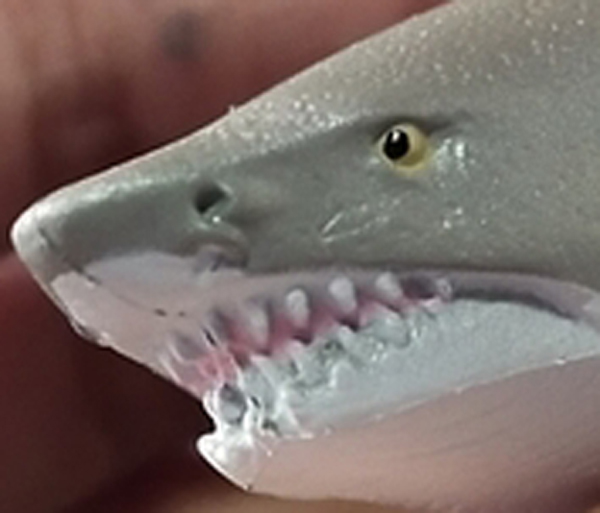
Here it is scaling well with some other fish in the 1:20 scale: the safari ltd Monterey Bay Aquarium manta ray, Papo hammerhead shark, Colorata Napoleon wrasse and CollectA bowmouth guitarfish:

Overall, this sand tiger shark is a fantastic representation of a popular shark in public aquariums and it has became my favourite shark from Safari ltd! It’s still relatively in the appropriate scale too, accurate and relatively inexpensive. This figure is relatively new on the market so it is still in production and it being a popular species for aquaria, may become a hot seller and I wish it will stay in production for many more years to come. This is the first standard-sized figure of this species but not the first figure of this species. Kaiyodo has 2 versions and Colorata has one: all relatively small, but fit well in the 1:40 scale range. This shark is my third favourite shark species, behind the hammerhead and the whale and this figure gets the stamp of approval from me!
Disclaimer: links to Ebay and Amazon on the AnimalToyBlog are affiliate links, so we make a small commission if you use them. Thanks for supporting us!




A great figure that I still have to pick up. Although I am bothered by the teeth being part of the sculpt I understand the reasoning behind it. Great review, well done!
thanks for the great informative review. I just received this figure recently and agree that it is one of Safari’s best sharks
Update: the safari ltd monterey bay aquarium Manta ray is advertised as 1:20 scale but can be upwards of 1:26 up to 1:39 scale
it’s a multi purpose figure. Mantas average about 12 to 16 feet across but have grown to over 25 feet or more IIRC this Safari Manta is a bit over 8 inches across, so 1/18 to 1/39 are all reasonable.
It’s 9 inches when full stretched out